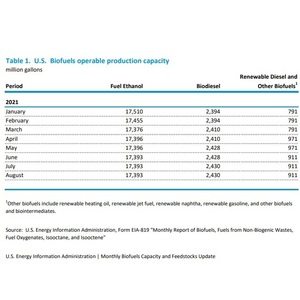EIA: US biofuel capacity flat in August, feedstock use down

October 29, 2021
BY Erin Voegele
Operatable biofuels production capacity in the U.S. remained steady at 20.734 billion gallons per year in August. Biofuel feedstock consumption, at 24.948 billion pounds, was down 1.938 billion pounds when compared to July, according to data released by the U.S. Energy Information Administration on Oct. 29.
According to the EIA, 17.393 billion gallons of operable ethanol capacity was in place as of August, a figure that has remained flat since April. Biodiesel capacity, at 2.43 billion gallons, was flat with July. Capacity for renewable diesel and other renewable fuels, defined as renewable heating oil, renewable jet fuel, renewable naphtha, renewable gasoline and other biofuels and biointermediates, was at 911 million gallons per year, a level maintained since June.
The EIA estimates 23.196 billion pounds of corn and 30 million pounds of grain sorghum were used to produce biofuels in August, down from 25.096 billion pounds and 32 million pounds, respectively, in July.
Advertisement
Approximately 815 million pounds of soybean oil was consumed as biofuel feedstock in August, up from 792 million pounds in July. Canola oil feedstock consumption also grew, from 123 million pounds in July to 142 million pounds in August. Corn oil consumption, however, fell to 199 million pounds, down from 237 million in July. Consumption levels for other forms of vegetable oils were withheld to avoid disclosure of individual company data.
An estimated 506 million pounds of waste oils, fats and greases were used to produce biofuels in August, including 305 million pounds of yellow grease, 120 million pounds of beef tallow, 55 million pounds of white grease, 18 million pounds of poultry fat, and 8 million pounds of other waste oils, fats and greases. Approximately 544 million pounds of fats, oils and greases went to biofuel production in July, including 331 million pounds of yellow grease, 129 million pounds of beef tallow, 59 million pounds of white grease, 21 million pounds of poultry fat, and 4 million pounds of other waste oils, fats and greases.
An additional 60 million pounds of feedstock classified as other recycled feeds and wastes went to biofuel production in August, down from 62 million pounds in July. The EIA withheld data on the consumption of yard and food waste feedstock and feedstock classified as other biofuels feedstocks not elsewhere specified or identified to avoid disclosure of individual company data.
Advertisement
Related Stories
With exclusive licensing to a camelina seed variety, Ash Creek Renewables is breaking down barriers to a renewable future.
Keolis Commuter Services, the Massachusetts Bay Transportation Authority’s operations and maintenance partner for the Commuter Rail, has launched an alternative fuel pilot utilizing renewable diesel for some locomotives.
Virgin Australia and Boeing on May 22 released a report by Pollination on the challenges and opportunities of an International Book and Claim system for sustainable aviation fuel (SAF) accounting.
Chevron U.S.A. Inc. on May 15 filed a notice with the Iowa Workforce Development announcing plans to layoff 70 employees at its Ames, Iowa, location by June 18. The company’s Chevron REG subsidiary is headquartered in Ames.
Luxury North Dakota FBO, Overland Aviation—together with leading independent fuel supplier, Avfuel Corp.— on May 19 announced it accepted a 8,000-gallon delivery of sustainable aviation fuel (SAF) on May 12.
Upcoming Events










